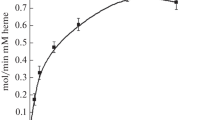Summary
-
1.
By difference spectrophotometry the cytochrome pattern of two strains of Rhizobium leguminosarum — effective and partly-effective — was studied in pure culture and in bacteroids isolated from legume root nodulesFootnote 1.
-
2.
In pure culture both strains contained cytochromes c, b and a-a 3 as well as cytochrome a 2 which appeared under semi-anaerobic conditions, especially in the effective strain. In Rhizobia cytochrome a 2 was detected for the first time.
-
3.
Bacteroids of the effective strain contained cytochromes c, b and some CO-reactive pigments which remained incompletely identified. Bacteroids of the partly-effective strain contained cytochrome a (a = peak at 597 nm at − 196°) which was absent from bacteroids of the effective strain.
-
4.
The data obtained show that the low O2 concentration within nodules does not seem to be the only factor responsible for the absence of cytochromes a from N2-fixing bacteroids.
Similar content being viewed by others
Notes
The term bacteroids is applied to all forms of the specific strain of bacteria isolated from root nodules.
References
Appleby, C. A., A soluble haemoprotein P-450 from nitrogen fixing Rhizobium bacteroids. Biochim. Biophys. Acta 147, 399 (1967).
Appleby, C. A., Electron transport systems of Rhizobium japonicum. I. Haemoprotein P-450, other CO-reactive pigments, cytochromes and oxidases in bacteroids from N2-fixing root nodules. Biochim. Biophys. Acta 172, 71 (1969).
Appleby, C. A., Electron transport systems of Rhizobium japonicum. II. Rhizobium haemoglobin, cytochromes and oxidases in free-living (cultured) cells. Biochim. Biophys. Acta 172, 88 (1969).
Appleby, C. A., Properties of leghaemoglobin in vivo and its isolation as ferrous oxyleghaemoglobin. Biochim. Biophys. Acta 188, 222 (1969).
Appleby, C. A. and Bergersen, F. J., Cytochromes of Rhizobium. Nature 182, 1174 (1958).
Arima, K. and Oka, T., Cyanide resistance in Achromobacter. I. Induced formation of cytochrome a 2 and its role in cyanide resistant respiration. J. Bacteriol. 90, 734 (1965).
Bergersen, F. J., The cytology of bacteroids from root nodules of subterranean clover. (Trifolium subterraneum L.) J. Gen. Microbiol. 13, 411 (1955).
Bergersen, F. J., Nitrogen fixation in legume root nodules: biochemical studies with soybean. Proc. Roy. Soc. 172, 401 (1969).
Bergersen, F. J., Biochemistry of symbiotic nitrogen fixation in legumes. Ann. Rev. Plant Physiol. 22, 121 (1971).
Bergersen, F. J. and Turner, G. L., Comparative studies of nitrogen fixation by soybean root nodules, bacteroid suspensions and cell-free extracts. J. Gen. Microbiol. 53, 205 (1968).
Burris, R. H. and Wilson, P. W., Respiratory enzyme in symbiotic nitrogen fixation. Gold Spring Harbour Symp. Quant. Biol. 7, 349 (1939).
Butler, W. L., Absorption spectroscopy in vivo: theory and application. Ann. Rev. Plant Physiol. 15, 451 (1964).
Daniel, R. M. and Appleby, C. A., Anaerobic-nitrate, symbiotic and aerobic growth of Rhizobium japonicum: effect on cytochrome P-450, other haemoproteins, nitrate and nitrite reductases. Biochim. Biophys. Acta 275, 347 (1972).
Dixon, R. O. D., Rhizobia (with particular reference to relationships with host plants). Ann. Rev. Microbiol. 23, 137 (1969).
Elkan, G. H., Biochemical and genetical aspects of the taxonomy of Rhizobium japonicum. Plant and Soil, Spec. Vol. 85 (1971).
Falk, J. E., Appleby, C. A., and Porra, R. J., The nature function and biosynthesis of the haem compounds and porphyrins of legume root nodules. Sympos. Soc. Exptl. Biol. 13, 73 (1959).
Gelman, N. S., Lukoyanova, M. A., and Ostrovsky, D. N., Bacterial Membranes and Respiratory Chain. ‘Nauka’, Moscow, 1972.
Hughes, D. E., A press for disrupting bacteria and other microorganisms. Brit. J. Exptl. Pathol. 32, 97 (1951).
Jones, C. W. and Redfearn, E. R., Electron transport in Azotobacter vinelandii. Biochim. Biophys. Acta 113, 467 (1966).
Jones, C. W. and Redfearn, E. R., The cytochrome system of Azotobacter vinelandii. Biochim. Biophys. Acta 143, 340 (1967).
Johnson, G. V., Evans, H. I., and Ching, M. T., Enzymes of the glyoxyilate cycle in Rhizobia and nodules of legumes. Plant Physiol. 41, 1330 (1966).
Author information
Authors and Affiliations
Rights and permissions
About this article
Cite this article
Kretovich, W.L., Romanov, V.I. & Korolyov, A.V. Rhizobium leguminosarum cytochromes (Vicia faba). Plant Soil 39, 619–634 (1973). https://doi.org/10.1007/BF00264179
Issue Date:
DOI: https://doi.org/10.1007/BF00264179




